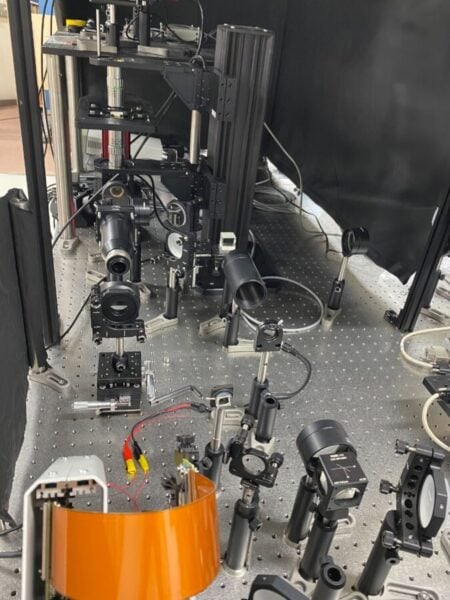Japanese researchers have developed a camera that can record three-dimensional holographic videos with just a single pixel. The device can also capture images outside the visible light spectrum and even through biological tissues, potentially changing how scientists observe living cells and tissues in their natural state.
The new technology from Kobe University, published this week in the journal Optics Express, combines the best features of existing holographic techniques while eliminating their limitations. Unlike conventional photography that captures flat images, holograms contain three-dimensional information, allowing viewers to see depth and perspective from different angles.
Seeing Through Obstacles
In a striking demonstration, the research team successfully filmed a moving object through a mouse skull – a feat impossible with traditional cameras. This capability could enable medical researchers to observe cellular processes through living tissues without invasive procedures.
“We expect this to be applied to minimally invasive, three-dimensional biological observation, because it can visualize objects moving behind a scattering medium,” explains lead researcher Naru Yoneda from Kobe University.
Conventional cameras use millions of pixels to capture images, making this single-pixel approach seem counterintuitive. But the technology’s simplicity is actually its strength, allowing it to work with types of light that conventional sensors can’t detect.
Breaking the Speed Barrier
Previous single-pixel holographic techniques could only photograph stationary objects because they were too slow to capture movement. The Kobe team solved this limitation by incorporating a high-speed “digital micromirror device” that projects patterns onto the object at unprecedented speeds.
“This device operates at 22 kHz, whereas previously used devices have a refresh rate of 60 Hz. This is a speed difference that’s equivalent to the difference between an old person taking a relaxed stroll and a Japanese bullet train,” Yoneda notes.
While the current prototype captures video at just over one frame per second, the researchers have shown mathematically that they could achieve standard video rates of 30 frames per second using optimization techniques.
How It Works
The camera operates on principles different from conventional photography:
- Instead of capturing reflected light all at once, it projects specially designed patterns onto the subject
- A single light detector measures how much light bounces back from each pattern
- Advanced algorithms convert these measurements into a three-dimensional holographic image
- The high-speed digital micromirror device projects these patterns 22,000 times per second
- A technique called “sparse sampling” allows the system to reconstruct complete images without measuring every point
This approach not only enables imaging through obstacles but also works with wavelengths of light that conventional camera sensors can’t detect, such as infrared or ultraviolet.
Real-World Applications
The technology’s ability to see through scattering media like tissues makes it especially valuable for biological research. Traditional microscopes struggle to image cells deep within tissues because light scatters as it passes through biological structures.
The single-pixel holographic camera bypasses this limitation, potentially allowing scientists to observe living cells functioning within intact tissues. This could advance our understanding of cellular processes in their natural environment rather than in artificial laboratory conditions.
Beyond biology, the technology could find applications in industrial inspection, security scanning, and advanced sensing in harsh environments where conventional cameras fail.
Challenges Ahead
Despite its promise, the technology still faces obstacles before reaching widespread use. Yoneda acknowledges these limitations: “There are still obstacles to overcome. We need to increase the number of sampling points, and also the image quality. For that, we are now trying to optimize the patterns we project onto the samples and to use deep-learning algorithms for transforming the raw data into an image.”
The research team is exploring ways to enhance image quality through artificial intelligence and optimize the pattern projection process. They’re also working to increase the frame rate for capturing faster-moving subjects.
What makes this technology particularly exciting is how it combines simplicity with capability. While modern smartphone cameras pack hundreds of millions of pixels into complex sensors, this approach demonstrates that sophisticated imaging is possible with just a single detector point and clever computational techniques.
As scientists continue refining these techniques, we may soon see holographic microscopes that allow researchers to observe biological processes in unprecedented detail, potentially transforming our understanding of how living systems function at the cellular level.
If our reporting has informed or inspired you, please consider making a donation. Every contribution, no matter the size, empowers us to continue delivering accurate, engaging, and trustworthy science and medical news. Independent journalism requires time, effort, and resources—your support ensures we can keep uncovering the stories that matter most to you.
Join us in making knowledge accessible and impactful. Thank you for standing with us!

